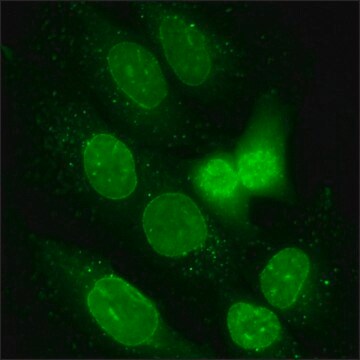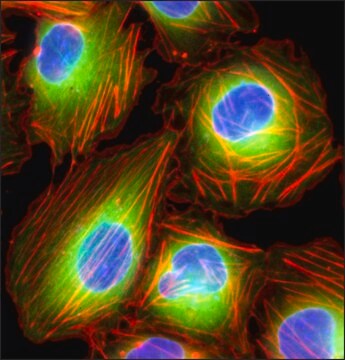U-2 OS Cell Line human
NOTE: Both the cell line and DNA from the cell line may be available for this product. Please choose -1VL or VIAL for cells, or -DNA-5UG for DNA, 92022711, human bone, Not specified
Synonyme(s) :
U-2OS Cells, U2-OS Cells, U20S Cells, U2OS Cells
About This Item
Produits recommandés
Source biologique
human bone
Conditionnement
tube of 5 μg 92022711-DNA-5UG
pkg of vial of cells 92022711-1VL
Mode de croissance
Adherent
Caryotype
Not specified
Morphologie
Not specified
Produits
Not specified
Récepteurs
Not specified
Technique(s)
cell culture | mammalian: suitable
Maladie(s) pertinente(s)
cancer
Conditions d'expédition
dry ice
Température de stockage
−196°C
Origine de la lignée cellulaire
Description de la lignée cellulaire
Application
- the importance of cyclin D1 for the activity of lithocholic acid hydroxyamide (LCAHA)
- the interaction of human single-stranded DNA binding protein 1 (hSSB1) with bloom syndrome protein helicase (BLM helicase)
- calcium-mediated actin reset (CaAR) in response to physiological changes
Profil d'ADN
CSF1PO: 13
D13S317: 13
D16S539: 11,12
D5S818: 11
D7S820: 11,12
THO1: 6,9.3
TPOX: 11,12
vWA: 14,18
Milieu de culture
Procédure de repiquage
Autres remarques
Faites votre choix parmi les versions les plus récentes :
Certificats d'analyse (COA)
It looks like we've run into a problem, but you can still download Certificates of Analysis from our Documents section.
Si vous avez besoin d'assistance, veuillez contacter Service Clients
Déjà en possession de ce produit ?
Retrouvez la documentation relative aux produits que vous avez récemment achetés dans la Bibliothèque de documents.
Articles
Regulation of the cell cycle involves processes crucial to the survival of a cell, including the detection and repair of genetic damage as well as the prevention of uncontrolled cell division associated with cancer. The cell cycle is a four-stage process in which the cell 1) increases in size (G1-stage), 2) copies its DNA (synthesis, S-stage), 3) prepares to divide (G2-stage), and 4) divides (mitosis, M-stage). Due to their anionic nature, nucleoside triphosphates (NTPs), the building blocks of both RNA and DNA, do not permeate cell membranes.
Notre équipe de scientifiques dispose d'une expérience dans tous les secteurs de la recherche, notamment en sciences de la vie, science des matériaux, synthèse chimique, chromatographie, analyse et dans de nombreux autres domaines..
Contacter notre Service technique

